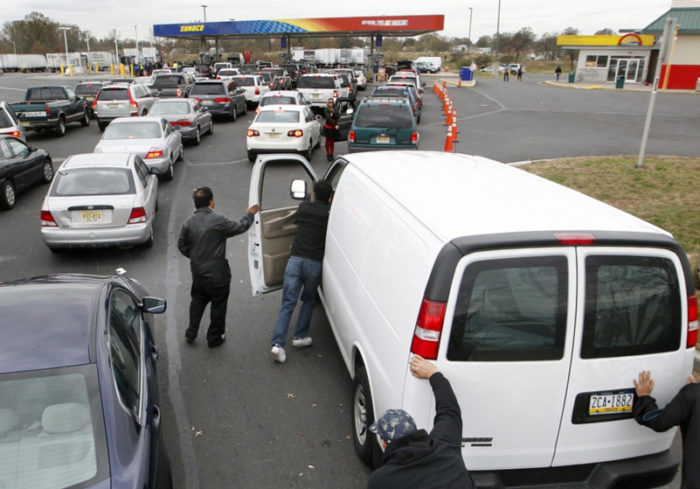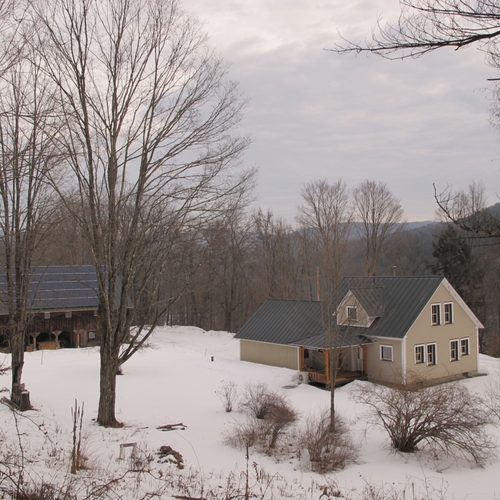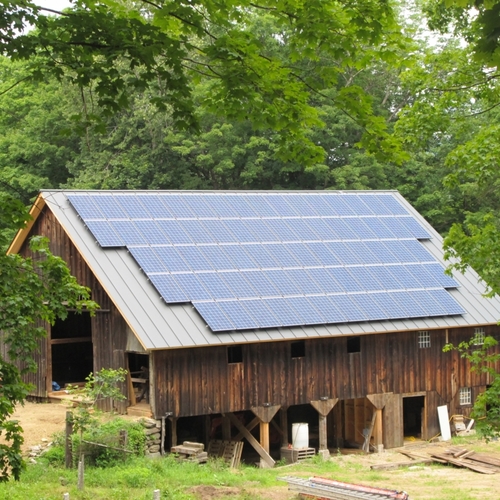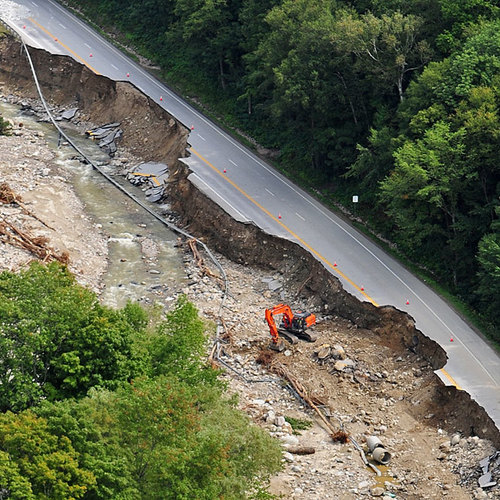Image Credit: AP
Image Credit: AP Gas lines became a traffic hazard in New Jersey and Long Island in the aftermath of Superstorm Sandy.
Image Credit: Sean Malone People waiting to fill gas cans to fuel their generators at a gas station in Madison Park, New Jersey on October 31st.
Image Credit: Lucas Jackson, Reuters
By now we’ve all seen the photos of houses buried in sand along the Jersey Shore, burned-out homes in Queens, and submerged subway stations in Manhattan. Those spectacular images were in the first wave of news from Superstorm Sandy last week.
The secondary, lingering effects might not be as dramatic, but they are nonetheless highly significant. And they demonstrate, ever so clearly, our need for greater resilience. As of late-afternoon Sunday, November 4th, there were still 1.8 million customers without power, the vast majority of them in New York and New Jersey. That’s down from 8.5 million without power at the peak, but it still includes almost a quarter of New Jersey. In some places outages may last for weeks.
Outages in August in New Jersey aren’t so bad — there might be some discomfort from the heat, but few at real risk of safety — but with temperatures dropping into the 30s early this week, power outages become quite serious. The vast majority of our heating systems require electricity to operate — for the fans, pumps, and controls — though there are some exceptions.
Power outages and gas stations
Along with these obvious problems of power outages — lack of lighting, heat, and appliances — power outages affect us outside the home as well.
As we learned in New Jersey and Long Island, without power most gas stations can’t operate. The American Automobile Association estimated on Thursday, November 1st, that 60% of service stations in New Jersey and 70% on Long Island were closed because they don’t have power to pump fuel. Only 23% of New Jersey service stations were still without power by Sunday morning, but lines persisted in many areas.
There were also actual fuel shortages, which contributed to the problems. The U.S. Department of Energy reported that 13 of the region’s 33 fuel terminals were closed as a result of the storm, along with two major gasoline pipelines serving the area.
Without gasoline, we can’t run our cars. But those shortages also meant that homeowners with smaller, gasoline-powered generators were running out of fuel.
Moving toward resilience
The solutions to these problems are many-faceted. Relative to the need for generators, we should build greater resilience into our homes. All homes should be able to maintain livable conditions in the event of loss of power or heating fuel. This is a familiar refrain of mine.
We can do this with much better building envelopes (significantly higher insulation levels, triple-glazed windows, tighter construction) and passive solar gain. With such features, the temperatures in those homes should never drop below 45 or 50 degrees Fahrenheit, even in the middle of winter if there’s no power and our heating systems can’t operate.
A mobile generator and battery bank
With the net-zero-energy house my wife and I are currently building (rebuilding) in Dummerston, Vermont, we’re thinking of installing a fairly conventional grid-connected solar-electric (PV) system, but using a new inverter that is coming out early next year that allows you to plug a load into it when the sun is shining — even when the grid is down. (Most grid-connected PV systems can’t operate when the grid is down, though the sun may be shining brightly.)
Rather than a battery bank for back-up electricity during power outages, we’re thinking of using the plug-in hybrid car we plan to buy for most of our emergency power needs. It will have a battery system (which we’ll normally charge using electricity from our PV array), so why install a second battery system that will only get used during occasional power outages. Our car can be our resilient power system.
Reducing dependence on cars
Relative to gasoline shortages and the inability to pump gas during outages, we can achieve greater resilience by reducing our dependence on the automobile. This isn’t a quick fix, but through involvement in local planning efforts and by influencing transportation funding priorities, we can produce more pedestrian-friendly spaces that allow people to reach key services safely on foot or by bicycle.
If we create communities that can function reasonably well without automobiles during times of emergencies, those will be places where automobile use may also drop during normal times. These will be cleaner, safer, healthier places that move us toward sustainability.
Final thoughts
Resilient design is about all of this. It is an integrated process that will keep us safer and allow us to bounce back more quickly from whatever the next disturbance might be.
Alex is founder of BuildingGreen, Inc. and executive editor of Environmental Building News. He also recently created the Resilient Design Institute. To keep up with Alex’s latest articles and musings, you can sign up for his Twitter feed.
Weekly Newsletter
Get building science and energy efficiency advice, plus special offers, in your inbox.
















13 Comments
Keep beating on that drum Alex.
I think the expression "resilient design" is not used nearly enough.
Unfortunately, the idea of designing for resilience doesn't seem all that popular...
Maybe partly because in many cases resiliency means means redundancy - which goes against the grain of economic efficiency.
And maybe partly because we're not ready to acknowledge that we've entered a new age where we need to start anticipating the occurance of historically unprecedented risks.
In a recent Q&A thread I took the position that "location efficiency" gains would probably not result in much energy actually saved (ie, not used) because of Jevon's paradox - but I wonder how much shorter those gas lines would have been/be if "location efficiency" were greater than it is now?
Simple answers first. Require
Simple answers first. Require gas stations to have back up power. Then yes require us all to live more resilient.
Fuel shortages were the bigger problem--not power at pumps
Yes, initially the shortages were due to gas stations not having power, but the bigger problem has been with the regional distribution of fuel. Most of the ports that provide fuel to the NYC tri-state area have been working at limited capacity, or not at all.
With power back in many coastal towns, the shortages are still getting worse in some places, particularly on Long Island. That, on top of the heavy damage done the the commuter-rail and subway systems, has prevented many people from going to work at all. Also, many parents are staying home, not because they can't get to work, but because their school districts still don't have gas for buses, so schools remain closed. Once people get a few gallons of gas, they're carefully planning every trip they make in the car to make their little bit of fuel count, because they have typically made multiple trips over the course of several days and/or waited in line for hours just to fill up one tank.
Where do you start when trying to make this huge web of interconnected resources more resilient?
Response to Rob Wotzak
Rob,
To answer your question: An electric car that is charged by a PV array. Ideally, the car owner also owns the PV array.
That's a very expensive solution that is out of reach for most Americans. For the rest of us, I guess the answer remains: a bicycle.
Response to Rob Wotzak
Rob,
As usual Martin cuts to the chase.
I don't think there are any easy answers to your question...
When you think of how long it took for the existing "system" to evolve the way it has (thanks in no small part to the abundant, cheap energy that's been available for the last century or so) it should probably come as no surprise that a transition to some new more resilient "system" should take as long.
Question is, what incentive is there to create the pressure needed to move away from the existing "system" to a new more resilient "system"?
Right now, change within the "system" is still driven mostly by policy based on a mixture of economic theories that were derived from observation made when the world was "empty" (ie these theories have never actually been tested against real resource scarcity).
Probably the best thing to do is lead by example.
When there are masses, and
When there are masses, and over populations, masses die, and they die for the better good.
Individually such fate sucks but such is life as of the last few billion years.
Survival is dicey in cities and the Adirondacks .
And sometimes for different reasons.
Honor thy earth.
Response to Rob Wotzak and related questions
I enjoyed your article. Could you give us details on the solar-powered battery-charging system and the "new" inverter? I used a small inverter (150 watt) in a houseboat and in a car to convert 12vdc to 120 volt ac for small appliances. I am looking for a larger one in case of an emergency.
Resilience by Alex Nov. 8th
I agree 100% with Alex on resilient building. Funnily enough, we did passive house open days last week- end on our passive house under construction in Mamaroneck NY and most people were interested by the resilience idea of passive house / super insulated building. A very new interest among our network that did not quite care about it since we started our renovation March this year...
I am also interested to hear from you Alex about those systems you are referring to for car charging( we are installing a 10kw PV system) and inverter.
My reply to Rob about incentives: what about another Sandy? People learn the hard way and Sandy has made us gained 10 years against the "we have a lot of cheap energy, why change?" Stance I have been hearing so often...
Resilient inverter and car charging
The car charging will work just like normal car charging, since it will be a net-metered, grid-connected PV system. I don't know a lot of details about the inverter I mentioned, but it will be made by SMA Americas in the Sunnyboy line. When I learn more details I will report them.
Using PV systems when the grid is down
I too would like more information on the use of a grid-tie PV system when the grid is down. A special inverter could be one solution, but it seems like you'd also need to rewire those appliances that you want to power directly from the PV system. I'd be happy to have just a manual switchover system that disconnects the grid and provides a fake signal that any conventional grid-tie inverter could sync to. Anyone know of a product like that?
Response to Scott Raney
Scott,
As long as you have a fat checkbook, and don't mind paying for (and maintaining) a big battery bank, you can have a grid-tied PV system with battery backup. The Outback Power GVFX3638 is capable of handling the wizardry. More information:
http://www.wholesalesolar.com/grid-tie-battery-backup.html
Outback Power GVFX3638
Bidirectional EV feed
Alex, Thank you for the article. I am familiar with several inverters that will provide backup for specified "protected loads" during a power outage but I have never seen a system that will allow bidirectional flow between an EV and the grid-tied PV system. I would love to learn more. Do you have any sources for products in this domain?
I wonder is this the backup system from SMA
Follow the link http://www.sma.de/produkte/backup-systeme.html
Or google "SMA Sunny Backup"
It is not available in the USA (no UL approval yet).
I have been looking at this for over a year wondering when / if it will come to the USA.
Any more information about the inverter you heard of would be if appreciated (it maybe this one / series). If it is the Sunny Backup series that plently of information is available - only not if/when it will come to the USA.
Log in or create an account to post a comment.
Sign up Log in